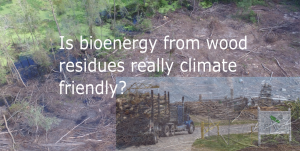 Biofuelwatch briefing about the definitions and impacts of forestry and wood-industry residues
Biofuelwatch briefing about the definitions and impacts of forestry and wood-industry residues
Click here to download the briefing
Summary:
Wood pellet and energy companies burning biomass often claim that they rely on wood residues or low-value wood, and there is a widely held conception that this translates into lower impacts on forests and less life-cycle greenhouse gas emissions
Unfortunately, this is based on a misconception of what those definitions mean. This briefing focusses on legal definitions used by the EU, however those concur with the general use of the terms ‘residues’ and ‘low-value wood’ by forestry industries, energy companies and governments around the world.
The main findings of the briefing are:
-
- Both the terms ‘low-value wood’ and ‘forestry residues’ are being widely used to include wood from whole trees;
- Both of those terms are based on economic considerations only, and take no account of the ecological, climate or cultural value of trees;
- One of the main arguments put forward for restricting forest biomass sourcing to ‘low-value wood’ and forestry residues is that the extent and intensity of logging is primarily driven by the demand for high-value wood products. Yet the income stream from selling large quantities of ‘low-value wood’ is the key economic driver behind more intensive logging in Eurrope and beyond;
- Even the use of sawmill residues for energy does not result in a positive climate balance and, furthermore, there such residues have long been fully utilised (including to provide processing heat for sawmills);
- Large-scale removal of + or slash from forest floors harms the health of soils, biodiversity, future tree growth and causes high emissions of CO2 from soils.
Thus, limiting subsidies to burning wood from wood processing or forestry residues, let alone so-called ‘low-value’ wood, cannot protect climate, forests, and biodiversity.
